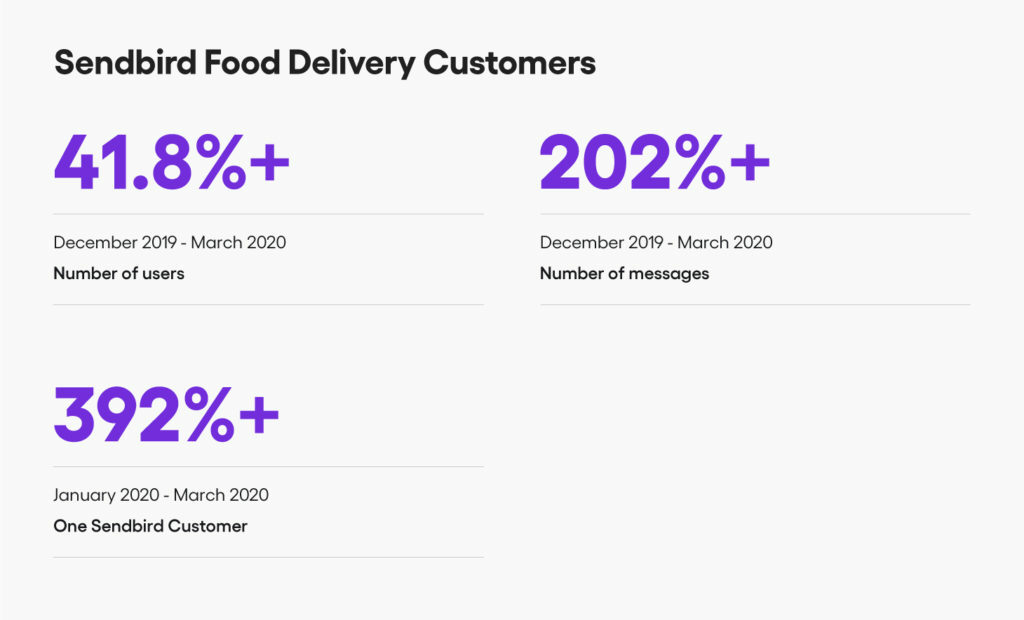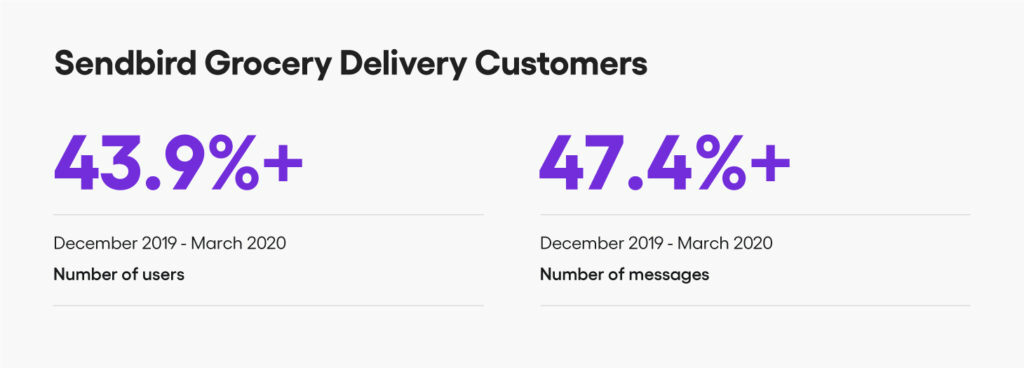Streamlined communication is the unsung hero for food delivery during COVID-19

Pre-COVID, on-demand food delivery apps were already poised for growth. Experts expected the industry to jump to $200 billion by 2025 (up from $82 billion in 2018). Enter COVID-19 and food delivery skyrocketed.
Social distancing requirements, safety concerns, and closed dining rooms fueled this boom. Food delivery during COVID became a convenient way for people to feel normal and stay safe during an abnormal time.
But this period of growth wasn’t without challenges. As delivery apps battled for market share, restaurants were learning how to offer delivery on their own. Fragmented processes, high delivery fees, and a competing grocery delivery market all threaten to derail food delivery’s growth. Companies that streamlined communication and overcame fragmented customer service with technology like in-app chat came out on top.
Immediate growth was apparent
At the onset of COVID, orders from delivery apps increased by 55%. By April, 32% of Americans had placed an order through a food delivery app, up from 22% in March.
Internally, we saw similar growth patterns. From December 2019 to the end of March, our food delivery clients saw their users increase by 41.8%, and their messages increase by 202%. One large Sendbird customer experienced a 392% jump in messages in the first three months of the year.
It was immediately clear that more people were using food delivery apps – but these percentages don’t paint the full picture.


Your order is on its way
Ensure it gets there with Sendbird.
Grocery delivery became part of the picture
The simultaneous rise of grocery delivery wasn’t as expected as food delivery’s skyrocketing demand. Internally, we saw our grocery delivery clients’ users grow by 43.9%, and messages increase by 47.4% between December and March.

Our experience wasn’t unique. Grocery delivery was taking off everywhere. By April, the total volume of online grocery orders had increased by 193%, and it continued to gain traction.
In May, Americans spent a total of $6.6 billion on online grocery sales, up 25% from April.
Around 52% of consumers have purchased groceries online since COVID started, and 62.5% plan to do it again soon. At this rate, experts expect the online grocery market to total $86.4 billion and consume 11.6% of the total grocery market.
A surprising number of people are opting to purchase large amounts of their food from grocery stores over restaurants, perhaps for concerns over restaurant sanitation. This unexpected swap added an unforeseen level of competition to an already competitive food delivery space.
Food delivery apps cannibalize
While the demand for food delivery during COVID was rising, the four primary players in the US food delivery market – DoorDash (44%), UberEats (23%), GrubHub (23%), and Postmates (8%) – strove to capitalize on the momentum.
In an attempt to take over, UberEats tried to acquire GrubHub, but the deal fell through. Instead, GrubHub was acquired by Dutch Food Delivery for $7.3 billion. UberEats then acquired Postmates for $2.65 billion.
As this all unfolded, more consumers were choosing grocery over take-out. Restaurants and smaller third-party apps began to consume portions of the market that the larger apps were vying for.
In the commotion, customers were losing out on quality interactions. Food delivery challenges became apparent, with many customers complaining about high delivery fees and subpar service, making the uphill battle even steeper.
Fragmented service and food delivery challenges impact demand
In the highly competitive market, on-demand apps were failing to provide adequate support to their customers and drivers, fueling frustration.
A US Foods study found that 39% of delivery drivers report frustration with unclear customer instructions, 37% regularly struggle to contact customers by phone, and 34% are frustrated with customers messaging with questions and complaints.
These issues threaten to derail food delivery’s momentum just as it’s starting to take flight.
Fixing these issues is easier than it may sound. It’s all about capitalizing on small moments in the customer experience and streamlining the process.
How to make the most of the current boom
To take advantage of the increase in food delivery during COVID, streamlining your process is a must. Add in-app chat, offer delivery receipts and ensure that your drivers, customers, and stores are all on the same page.
Whether you specialize in grocery or restaurant delivery, customer service and driver support through seamless communication that puts real-time status and answers at consumers’ fingertips are fundamental for success.
We’ve seen this firsthand. Our on-demand clients who have streamlined their offerings with features like in-app chat have reduced booking cancellations by 75%. Global on-demand players including Gojek, iFood, and Careem have found ongoing success using our in-app communication solutions.
To capitalize on the food delivery boom during the COVID era, you must streamline – immediately. Check out our totally free guide to in-app chat for your on-demand business.
We dive deep into implementing chat and measuring results, and offer a step-by-step game plan. Grab the guide now.










